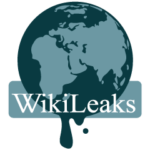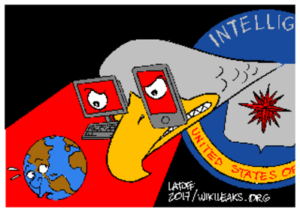Vault 7: Brutal Kangaroo
WHISTLEBLOWING - SURVEILLANCE, 26 Jun 2017
WikiLeaks – TRANSCEND Media Service
 Today, June 22nd 2017, WikiLeaks publishes documents from the Brutal Kangaroo project of the CIA. Brutal Kangaroo is a tool suite for Microsoft Windows that targets closed networks by air gap jumping using thumbdrives. Brutal Kangaroo components create a custom covert network within the target closed network and providing functionality for executing surveys, directory listings, and arbitrary executables.
Today, June 22nd 2017, WikiLeaks publishes documents from the Brutal Kangaroo project of the CIA. Brutal Kangaroo is a tool suite for Microsoft Windows that targets closed networks by air gap jumping using thumbdrives. Brutal Kangaroo components create a custom covert network within the target closed network and providing functionality for executing surveys, directory listings, and arbitrary executables.
The documents describe how a CIA operation can infiltrate a closed network (or a single air-gapped computer) within an organization or enterprise without direct access. It first infects an Internet-connected computer within the organization (referred to as “primary host”) and installs the BrutalKangaroo malware on it. When a user is using the primary host and inserts a USB stick into it, the thumbdrive itself is infected with a separate malware. If this thumbdrive is used to copy data between the closed network and the LAN/WAN, the user will sooner or later plug the USB disk into a computer on the closed network. By browsing the USB drive with Windows Explorer on such a protected computer, it also gets infected with exfiltration/survey malware. If multiple computers on the closed network are under CIA control, they form a covert network to coordinate tasks and data exchange. Although not explicitly stated in the documents, this method of compromising closed networks is very similar to how Stuxnet worked.
The Brutal Kangaroo project consists of the following components: Drifting Deadline is the thumbdrive infection tool, Shattered Assurance is a server tool that handles automated infection of thumbdrives (as the primary mode of propagation for the Brutal Kangaroo suite), Broken Promise is the Brutal Kangaroo postprocessor (to evaluate collected information) and Shadow is the primary persistence mechanism (a stage 2 tool that is distributed across a closed network and acts as a covert command-and-control network; once multiple Shadow instances are installed and share drives, tasking and payloads can be sent back-and-forth).
The primary execution vector used by infected thumbdrives is a vulnerability in the Microsoft Windows operating system that can be exploited by hand-crafted link files that load and execute programs (DLLs) without user interaction. Older versions of the tool suite used a mechanism called EZCheese that was a 0-day exploit until March 2015; newer versions seem use a similar, but yet unknown link file vulnerability (Lachesis/RiverJack) related to the library-ms functionality of the operating system.
Leaked Documents
Brutal Kangaroo — Drifting Deadline v1.2 – User Guide
EzCheese v6.2 – User Guide (Rev. B)
EzCheese v6.2 – User Guide (Rev. A)
EZCheese v6.2 – IVV TDR Slides
_______________________________________________
All Releases:
Vault 7: Cherry Blossom – 15 Jun 2017
Vault 7: Pandemic – 1 Jun 2017
Vault 7: Athena – 19 May 2017
Vault 7: AfterMidnight & Assassin Frameworks – 12 May 2017
Vault 7: Archimedes – 5 May 2017
Vault 7: Scribbles Project – 28 Apr 2017
Vault 7: Weeping Angel – 21 Apr 2017
Vault 7: Hive Project – 14 Apr 2017
Vault 7: Grasshopper Framework – 7 Apr 2017
Vault 7: Marble Framework – 31 Mar 2017
Vault 7: Project Dark Matter – 23 Mar 2017
Vault 7: CIA Hacking Tools Revealed – 7 Mar 2017
Go to Original – wikileaks.org
DISCLAIMER: The statements, views and opinions expressed in pieces republished here are solely those of the authors and do not necessarily represent those of TMS. In accordance with title 17 U.S.C. section 107, this material is distributed without profit to those who have expressed a prior interest in receiving the included information for research and educational purposes. TMS has no affiliation whatsoever with the originator of this article nor is TMS endorsed or sponsored by the originator. “GO TO ORIGINAL” links are provided as a convenience to our readers and allow for verification of authenticity. However, as originating pages are often updated by their originating host sites, the versions posted may not match the versions our readers view when clicking the “GO TO ORIGINAL” links. This site contains copyrighted material the use of which has not always been specifically authorized by the copyright owner. We are making such material available in our efforts to advance understanding of environmental, political, human rights, economic, democracy, scientific, and social justice issues, etc. We believe this constitutes a ‘fair use’ of any such copyrighted material as provided for in section 107 of the US Copyright Law. In accordance with Title 17 U.S.C. Section 107, the material on this site is distributed without profit to those who have expressed a prior interest in receiving the included information for research and educational purposes. For more information go to: http://www.law.cornell.edu/uscode/17/107.shtml. If you wish to use copyrighted material from this site for purposes of your own that go beyond ‘fair use’, you must obtain permission from the copyright owner.
Read more
Click here to go to the current weekly digest or pick another article:
WHISTLEBLOWING - SURVEILLANCE: